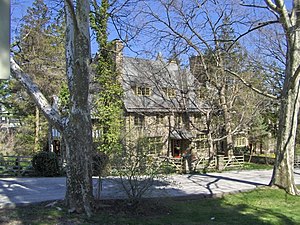Cotswold architecture: Difference between revisions
→Interiors: added information about fireplaces |
→Interiors: added information about mantles and inline citation |
||
| Line 20: | Line 20: | ||
=== Interiors === |
=== Interiors === |
||
Buildings of the Cotswold style typically have one or two large fireplaces with a chimney.<ref name=":1" /> |
Buildings of the Cotswold style typically have one or two large fireplaces with a chimney.<ref name=":1" /> The mantles are made of stone.<ref>{{Citation|last=Everitt|first=Alan|title=The English Urban Inn 1560–1760|date=1973|url=http://dx.doi.org/10.1007/978-1-349-00575-8_5|work=Perspectives in English Urban History|pages=91–137|place=London|publisher=Palgrave Macmillan UK|isbn=978-1-349-00577-2|access-date=2020-10-12}}</ref> |
||
== Examples == |
== Examples == |
||
Revision as of 22:52, 12 October 2020

The Cotswold style of architecture is a style based on houses from the Cotswold region of England, and is sometimes called the storybook style. It was first introduced during the late 16th century and flourished throughout the 17th century.[1]: 6 Roofs made with pseudo-thatch, steep arch gables, and arched doorways are all common features of the Cotswold style. Walls are usually sided in brick, stone, or stucco, and rooms are often small and irregularly shaped. Cotswold houses often have a prominent chimney, often near the front door of the house.[2]
Cotswold architecture is a subtype of the Tudor Revival house style, and it likely came to the United States as a result of a renewed interest in medieval housing styles. During the second and third decades of the twentieth century, the Cotswold style reached its zenith of popularity.
Influences
The Cotswold style of architecture is characterized by simplicity, due partly to the rural locations of many early Cotswold cottages and lack of access to building materials. It was also due to financial necessity; owners of the cottages had rural occupations, like sheep rearing.[2]
It later came to be influenced by the Classical style of architecture. These influences included the use of stucco on walls, which often replaced limewash.[3] Classical influences also affected the design of Cotswold cottages, leading to higher and wider lights and “loftier” rooms.[1]: 35
Structural Elements
The features of the Cotswold style are primarily identifiable through the use of specific materials. In the Cotswold region, lead was scarce and oolite limestone and hard wood are abundant.[4][2]
Exteriors
The leading feature of Cotswold architecture is the grouping of the gables, as a lack of lead resulted in the employment of slate.[2] [5] Due to the steepness of the roofs, most Cotswold cottages had dormer windows and were not waterproof.[1]: 32, 46 Occasionally, lead was employed in gutter systems around the roof.[1]: 10
The walls of Cotswold residences were similarly susceptible to the elements as, though they were thick, they were hollow and filled with rocks without any binding materials.[1]
The king mullion is a common element of the Cotswold style.[6] The windows of Cotswold cottages were glazed with lead, the only instances in which lead was used in smaller structures.[1]: 10
Interiors
Buildings of the Cotswold style typically have one or two large fireplaces with a chimney.[1] The mantles are made of stone.[7]
Examples
- Rufus Arndt House, Wisconsin.
- Coin St. Aldwyns[8]
- Rose Cottage at the Henry Ford[9]
External links
References
- ^ a b c d e f g Dawber, Edward Guy (1905). Old Cottages, Farm-houses, and Other Stone Buildings in the Cotswold District: Examples of Minor Domestic Architecture in Gloucestershire, Oxfordshire, Northants, Worcestershire, &c. B. T. Batsford.
- ^ a b c d Marsland, Ellis (March 1906). "The Architecture of the Cotsmolds in the 16th & 17th Centuries". Architect's Magazine. 6: 88 – via ProQuest.
- ^ Jordan, Tim; Walrond, Lionel (2014-04-15). The Cotswold House. Amberley Publishing Limited. ISBN 978-1-4456-3722-8.
- ^ Barron, A. J. M.; Sumbler, M. G.; Morigi, A. N. (1997-01-01). "A revised lithostratigraphy for the Inferior Oolite Group (Middle Jurassic) of the Cotswolds, England". Proceedings of the Geologists' Association. 108 (4): 269–285. doi:10.1016/S0016-7878(97)80012-0. ISSN 0016-7878.
- ^ "A Good School: 1939-1944 - A Tragic Honesty: The Life and Work of Richard Yates". erenow.net. Retrieved 2020-10-11.
- ^ Wood-Jones, Raymond B. (1963). Traditional Domestic Architecture of the Banbury Region. Manchester: Manchester University Press. p. 259.
- ^ Everitt, Alan (1973), "The English Urban Inn 1560–1760", Perspectives in English Urban History, London: Palgrave Macmillan UK, pp. 91–137, ISBN 978-1-349-00577-2, retrieved 2020-10-12
- ^ Cornish, Vaughan (1941-07-01). "A Record of the Changing Face of Britain". Nature. 148 (3743): 104–104. doi:10.1038/148104a0. ISSN 1476-4687.
- ^ Stening, Theo (2010). "Gloucestershire Across the Atlantic: The Story of a Traveling Cottage and Smithy" (PDF). Gloucestershire Society for Industrial Archaeology Journal: 39–42.
